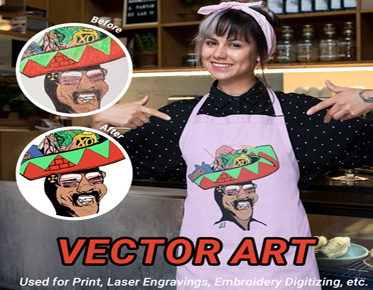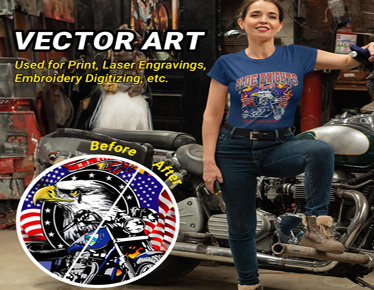Transforming Industries: An Introduction to Vector Graphics and Digitization
In today's technologically driven landscape, the convergence of vector graphics and digitization has revolutionized industries across the spectrum. From advertising to healthcare, vector graphics and digitization have become indispensable tools for innovation, efficiency, and visual communication. This article explores the multifaceted role of vector graphics and digitization in diverse industries, elucidating their impact, benefits, and future prospects.
The
Role of Digitization in Modern Industries
Overview of Digitization and Its
Impact on Industries
Digitization entails the transformation of analog processes and assets
into digital formats. Its widespread adoption has profoundly influenced
industries, fostering automation, data-driven decision-making, and enhanced
connectivity. From manufacturing to education, digitization has reshaped
traditional paradigms, driving efficiency and innovation.
Benefits of Embracing
Digitization
Embracing digitization offers myriad benefits, including increased
productivity, cost reduction, and enhanced agility. By digitizing workflows,
businesses can streamline operations, accelerate processes, and adapt swiftly
to market demands. Moreover, digitization facilitates access to real-time data,
enabling informed decision-making and strategic planning.
The Intersection of Vector
Graphics and Digitization
Vector graphics play a pivotal role in the digitization of visual communication, offering scalability, clarity, and versatility. From creating digital assets for marketing campaigns to designing interactive educational materials, vector graphics amplify the impact of digitization across industries. By harnessing the power of vectors, businesses can effectively convey information, engage audiences, and cultivate brand identity in the digital realm.
Advertising
and Marketing
Creating Impactful
Advertisements with Vector Graphics
Vector graphics empower advertisers to craft visually compelling
advertisements that capture attention and evoke emotions. Their scalability
ensures crisp rendering across various platforms and devices, enhancing brand
visibility and audience engagement. From sleek logos to dynamic banners, vector
graphics enable marketers to convey brand messages with clarity and
sophistication.
Vector Graphics in Digital Marketing
Campaigns
In the realm of digital marketing, vector graphics serve as indispensable assets for creating immersive online experiences. From social media posts to website visuals, vectors enable marketers to convey complex ideas and narratives with precision and style. Their adaptability facilitates seamless integration into multimedia campaigns, driving customer engagement and conversion rates.
Web
Design and Development
Vector Graphics for Scalable and
Responsive Web Design
Vector graphics revolutionize web design by offering scalability and
responsiveness across devices and screen sizes. Scalable Vector Graphics (SVGs)
ensure fast loading times and high-quality visuals, enhancing user experience
and search engine optimization. From logos to illustrations, vectors enable
designers to create dynamic, visually appealing websites that captivate and
inform visitors.
Using SVGs for Fast Loading and
High-Quality Images
SVGs have emerged as the preferred format for web imagery due to their
lightweight nature and compatibility with modern browsers. Their ability to
maintain visual fidelity at any size ensures fast loading times and crisp
rendering, optimizing website performance and user engagement. By incorporating
SVGs into web design, businesses can deliver seamless browsing experiences that
leave a lasting impression on visitors.
Examples of Websites Utilizing
Vector Graphics Effectively
Numerous websites exemplify the effective integration of vector graphics to enhance aesthetics and functionality. From interactive infographics to animated backgrounds, examples showcase how vectors elevate user experience and brand identity online. By studying these websites, designers can glean inspiration and best practices for incorporating vector graphics into their own projects.
Print
Media and Publishing
Benefits of Vector Graphics in
Print Design
In print media and publishing, vector graphics offer unparalleled
clarity, ensuring sharp and crisp output in various formats. From brochures to
billboards, vectors facilitate the creation of high-quality print materials
that captivate and inform audiences. Their scalability and resolution
independence enable designers to achieve precise layouts and typography,
enhancing readability and visual appeal.
High-Quality Publications Using
Vector Illustrations
Vector illustrations enrich publications with visually compelling
imagery that enhances reader engagement and comprehension. Whether in
magazines, textbooks, or posters, vectors imbue printed materials with a level
of detail and sophistication unattainable with raster graphics. By
incorporating vector illustrations, publishers can elevate the quality and
impact of their content, fostering greater reader satisfaction and retention.
Transitioning from Traditional
to Digital Print Media
The transition from traditional to digital print media presents new opportunities for leveraging vector graphics. Digital publishing platforms enable dynamic content creation and distribution, empowering publishers to reach wider audiences with interactive experiences. By embracing vector graphics in digital print media, publishers can adapt to evolving consumer preferences and market trends, positioning themselves for sustained growth and innovation.
Animation
and Multimedia
Introduction to Vector Animation
Vector animation offers a versatile and scalable approach to creating
dynamic multimedia content. From animated logos to interactive presentations,
vectors enable seamless motion graphics that captivate and inform audiences.
Their lightweight nature and resolution independence make them ideal for
streaming and sharing across various platforms and devices.
Tools and Techniques for
Creating Vector Animations
Leading animation software such as Adobe Animate and After Effects
provide designers with robust tools for creating vector-based animations. From
keyframe animation to motion paths, these tools empower animators to bring
static vectors to life with seamless movement. By mastering these techniques,
designers can unleash their creativity and produce captivating animations that resonate
with audiences.
Popular Uses of Vector Graphics
in Animation
Vector graphics find diverse applications in animation, spanning from explainer videos to interactive presentations. Their ability to convey complex ideas with clarity and elegance makes them indispensable assets in the realm of multimedia storytelling. By incorporating vector graphics into animation projects, creators can elevate their storytelling and engage audiences in immersive experiences.
Fashion
and Textile Industry
Designing Patterns and Prints
with Vector Graphics
Vector graphics serve as the foundation for designing intricate
patterns and prints in the fashion and textile industry. Designers leverage
vectors to create scalable motifs that adorn fabrics, garments, and accessories
with precision and style. From geometric patterns to floral motifs, vectors
offer endless possibilities for expressing creativity and innovation in fashion
design.
The Role of Vector Graphics in
Fashion Tech
Fashion tech integrates vector graphics with cutting-edge technologies
to revolutionize design processes and consumer experiences. From virtual
fitting rooms to personalized apparel customization, vectors drive innovation
at the intersection of fashion and technology. By leveraging vector graphics in
fashion tech, brands can enhance product development, customer engagement, and
brand loyalty in the digital age.
Notable Fashion Designers Using
Vector Graphics
Renowned fashion designers harness the power of vector graphics to realize their creative visions and push the boundaries of sartorial expression. Case studies of iconic fashion collections underscore the transformative impact of vectors on contemporary design aesthetics. By analyzing these designers' use of vector graphics, aspiring fashion creatives can gain insights and inspiration for their own collections.
Architecture
and Urban Planning
Precision and Scalability in
Architectural Designs
Vector graphics underpin architectural designs, offering architects
and urban planners unparalleled precision and scalability. From drafting
blueprints to visualizing spatial layouts, vectors streamline the design
process and facilitate seamless collaboration. Their resolution independence
ensures clarity and accuracy in conveying architectural concepts and
specifications.
Using Vector Graphics for Urban
Planning Visualizations
Urban planners leverage vector graphics to create immersive visualizations of urban landscapes, facilitating data-driven decision-making and stakeholder engagement. These visualizations elucidate proposed developments and infrastructural changes, fostering informed urban planning strategies and promoting community participation. By employing vectors in urban planning visualizations, planners can communicate complex ideas effectively, solicit feedback, and foster consensus among stakeholders.
Engineering
and Manufacturing
Technical Drawings and
Schematics with Vector Graphics
Vector graphics are indispensable in engineering and manufacturing for
creating technical drawings, schematics, and diagrams. Designers leverage
vectors to illustrate complex components, assemblies, and processes with
precision and clarity. Their scalability ensures that technical documentation
remains legible and accurate across different viewing scales, facilitating
manufacturing and assembly processes.
The Importance of Vector
Graphics in CAD Software
Computer-aided design (CAD) software relies heavily on vector graphics
for modeling and visualization purposes. Vectors enable engineers to create
detailed 2D and 3D representations of mechanical parts, architectural
structures, and industrial machinery. By harnessing the power of vectors in CAD
software, engineers can streamline design iterations, optimize product
performance, and expedite time-to-market.
Streamlining Manufacturing
Processes with Digitization
Digitization has revolutionized manufacturing by enabling the adoption of Computer-Aided Manufacturing (CAM) systems, which integrate seamlessly with CAD software. Vectors generated in CAD applications serve as blueprints for CNC machining, 3D printing, and other automated manufacturing processes. By digitizing manufacturing workflows, businesses can achieve greater efficiency, accuracy, and cost-effectiveness in production.
Education
and E-Learning
Enhancing Educational Materials
with Vector Graphics
Vector graphics enhance educational materials by providing clear
visual representations of concepts, processes, and data. Teachers and
instructional designers use vectors to create diagrams, charts, and
infographics that facilitate learning and retention. Their scalability ensures
that educational materials remain legible and visually engaging across different
formats and platforms.
Interactive E-Learning Modules
Using Vector Illustrations
E-learning platforms leverage vector graphics to create interactive
modules that cater to diverse learning styles and preferences. Vectors enable
the customization of learning experiences through interactive quizzes,
simulations, and multimedia presentations. By incorporating vectors into
e-learning content, educators can foster active engagement, critical thinking,
and knowledge retention among learners.
Success Stories: Schools and
Universities Implementing Vector Graphics
Schools and universities worldwide have embraced vector graphics to enhance teaching and learning experiences across disciplines. Success stories highlight how educators leverage vectors to create engaging lesson materials, digital textbooks, and online courses. By sharing best practices and innovative uses of vector graphics, educational institutions can inspire others to harness the power of digital visualization in education.
Healthcare
and Medical Visualization
Medical Illustrations and
Infographics Using Vector Graphics
Vector graphics play a vital role in medical communication by
visualizing complex anatomical structures, physiological processes, and medical
procedures. Medical illustrators use vectors to create detailed illustrations,
diagrams, and infographics for textbooks, journals, and patient education
materials. Their clarity and precision aid in conveying medical information
accurately and comprehensively to diverse audiences.
Vector Graphics in Health Tech
and Telemedicine
Healthcare technologies leverage vector graphics to develop user
interfaces, medical imaging systems, and telemedicine platforms. Vectors enable
the creation of intuitive interfaces that enhance user experience and clinical
workflow efficiency. By integrating vectors into health tech solutions,
developers can improve patient outcomes, streamline healthcare delivery, and
expand access to medical services.
The Future of Medical
Visualization with Digitization
The future of medical visualization lies in digitization, augmented reality (AR), and virtual reality (VR) technologies. These emerging tools enable immersive exploration of anatomical structures, surgical simulations, and patient-specific treatment planning. By harnessing the potential of digitization and vector graphics, healthcare professionals can revolutionize medical education, diagnostics, and patient care in the 21st century.
Gaming
Industry
Creating Game Assets with Vector
Graphics
Vector graphics are widely used in the gaming industry for creating
game assets, including characters, environments, and user interfaces. Game
developers leverage vectors to achieve stylized visuals, smooth animations, and
optimized performance across different platforms. Their scalability and
efficiency streamline the game development process and facilitate iterative
design iterations.
Benefits of Vector Graphics in
Mobile and Indie Games
Mobile and indie game developers favor vector graphics for their
flexibility, small file sizes, and compatibility with diverse hardware
specifications. Vectors enable developers to create visually stunning games
that run smoothly on smartphones, tablets, and low-power devices. By leveraging
vectors, indie developers can compete with larger studios and deliver
high-quality gaming experiences to a global audience.
Examples of Popular Games Using
Vector Illustrations
Numerous popular games incorporate vector graphics to achieve distinctive art styles and memorable visual identities. From indie darlings to AAA titles, examples showcase how vectors enhance storytelling, gameplay mechanics, and player immersion. By studying these games, aspiring game developers can learn valuable lessons in art direction, asset optimization, and visual communication in game design.
Film
and Television
Vector Graphics in Title
Sequences and Motion Graphics
Vector graphics are widely used in film and television for creating
dynamic title sequences, motion graphics, and visual effects. Designers
leverage vectors to achieve smooth animations, vibrant colors, and intricate
typography that captivate audiences from the outset. Their scalability ensures
that graphics maintain crispness and clarity, even on high-definition screens
and cinema projectors.
Enhancing Visual Effects with
Vector-Based Techniques
Visual effects artists incorporate vector-based techniques to achieve
photorealistic renders, dynamic simulations, and immersive environments in film
and television productions. Vectors enable precise control over lighting,
shading, and texture mapping, enhancing the realism and believability of CGI
elements. By combining vectors with raster graphics and 3D rendering, VFX
artists push the boundaries of visual storytelling and cinematic immersion.
The Growing Use of Vector
Graphics in TV Production
Television production relies on vector graphics for creating on-screen graphics, lower thirds, and animated overlays in news broadcasts, sports coverage, and entertainment programs. Vectors enable broadcasters to deliver informative and visually appealing content in real time, enhancing viewer engagement and comprehension. By incorporating vectors into TV production workflows, broadcasters can streamline graphics creation and adapt quickly to evolving programming needs.
Retail
and E-Commerce
Product Design and Packaging
Using Vector Graphics
Retailers and e-commerce companies leverage vector graphics for
product design, packaging, and branding initiatives. Vectors enable designers
to create scalable logos, labels, and packaging designs that maintain visual
integrity across different product lines and marketing channels. Their
flexibility facilitates customization and personalization, catering to diverse
consumer preferences and market segments.
Vector Graphics for E-Commerce
Websites and Apps
E-commerce websites and mobile apps utilize vector graphics to create intuitive user interfaces, product galleries, and checkout experiences. Vectors enable the seamless integration of high-resolution product images, interactive elements, and promotional banners that drive conversions and enhance user engagement. By optimizing e-commerce platforms with vectors, retailers can deliver compelling shopping experiences that inspire trust and loyalty among customers.
Sports
and Entertainment
Engaging Fan Experiences with
Vector Graphics
Sports and entertainment organizations leverage vector graphics to
create immersive fan experiences, stadium signage, and event branding
initiatives. Vectors enable the customization of logos, mascots, and
promotional materials that resonate with fans and enhance the atmosphere at
live events. By incorporating vectors into their marketing and branding
strategies, sports and entertainment entities can cultivate fan loyalty, drive
ticket sales, and expand their audience reach.
Vector Graphics in Sports
Analytics and Broadcasts
Sports analytics and broadcasting rely on vector graphics for
visualizing player statistics, game strategies, and interactive game
simulations. Vectors enable the creation of dynamic charts, diagrams, and
on-screen graphics that enhance commentary and analysis during live broadcasts.
Their scalability ensures that graphics remain clear and informative, even on
high-definition screens and mobile devices.
Examples of Sports Teams and
Events Using Vector Graphics
Sports teams and events leverage vector graphics to create iconic logos, jerseys, and merchandise that resonate with fans worldwide. From major leagues to grassroots organizations, examples showcase how vectors enhance brand identity, marketing campaigns, and fan engagement initiatives. By studying these examples, sports organizations can learn effective strategies for leveraging vector graphics to build strong, enduring connections with fans and sponsors.
Conclusion
In conclusion, the integration of vector graphics and digitization has
transformed industries across the spectrum, from advertising and marketing to
healthcare and aerospace engineering. By embracing vector graphics, businesses
and organizations can unlock new opportunities for creativity, efficiency, and
innovation in their respective fields. As technology continues to evolve and
digitalization accelerates, the role of vector graphics will only become more
prominent, shaping the future of design, communication, and human interaction.
Therefore, it is imperative for professionals and enthusiasts alike to explore
and harness the power of vector graphics to drive positive change and progress
in their industries. Whether you are a designer, engineer, educator, or
entrepreneur, the potential of vector graphics is limitless, offering endless
possibilities for expression, collaboration, and impact in the digital age. So,
let us continue to push the boundaries of creativity and imagination, armed
with the versatile tools of vector graphics, as we chart a course towards a
future where innovation knows no bounds.



